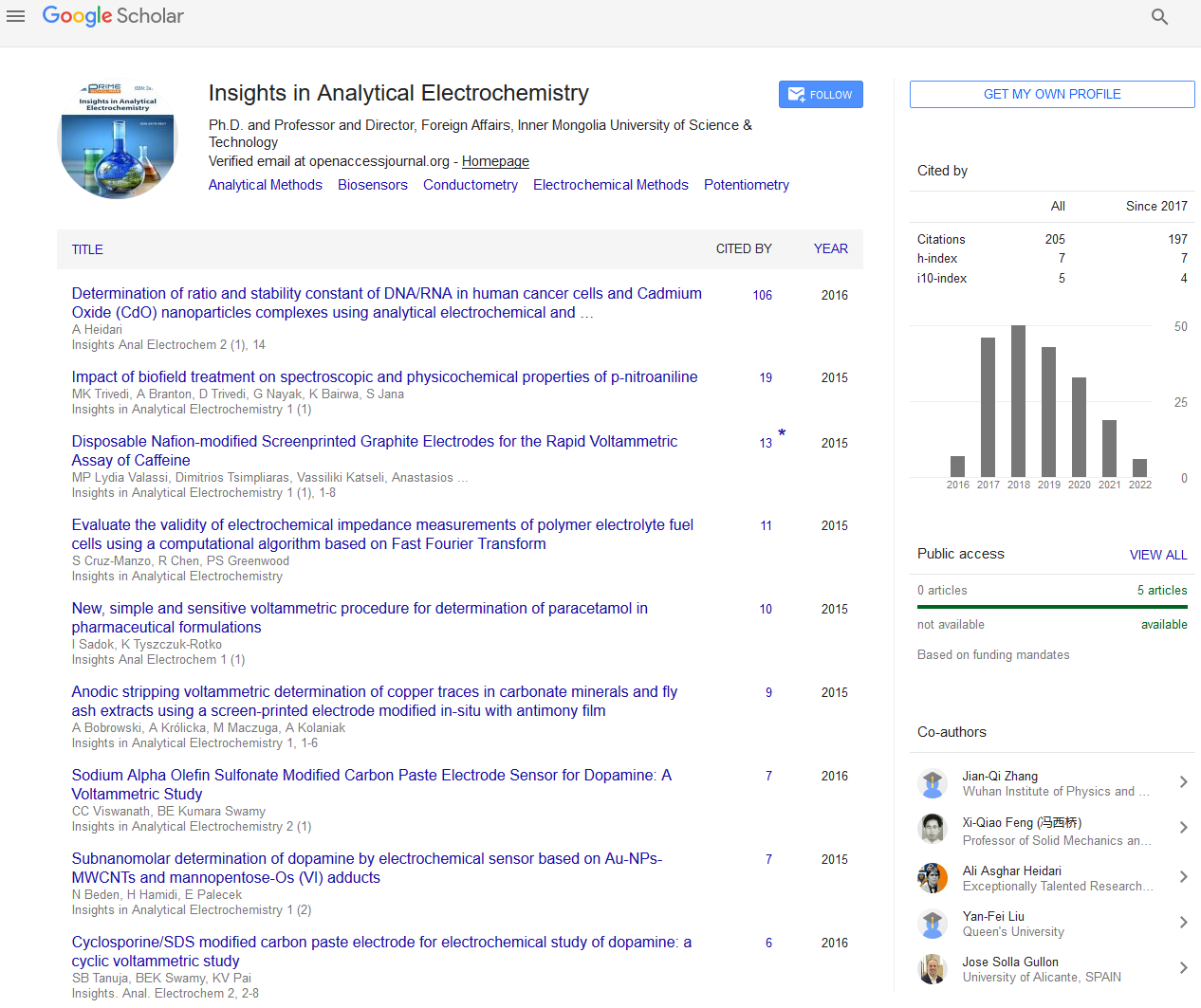Commentary Article - (2023) Volume 9, Issue 4
Conductometry: Harmonizing Chemical Solutions Through the Symphony of Electrical Signals
San Jose*
Department of Chemical and Biochemical Engineering, The University of Western Ontario, Canada
*Correspondence:
San Jose,
Department of Chemical and Biochemical Engineering, The University of Western Ontario,
Canada,
Email:
Received: 29-Nov-2023, Manuscript No. ipaei-24-18857;
Editor assigned: 01-Dec-2023, Pre QC No. ipaei-24-18857 (PQ);
Reviewed: 15-Dec-2023, QC No. ipaei-24-18857;
Revised: 20-Dec-2023, Manuscript No. ipaei-24-18857 (R);
Published:
27-Dec-2023, DOI: 10.21767/2470-9867-9.4.37
Description
In the expansive landscape of analytical chemistry,
conductometry takes center stage as a method that decodes the
intricate dance of ions in solutions. This technique, grounded in
the principles of conductivity, offers a unique perspective on
the unseen world of chemical interactions. Conductometry
serves as a conductor orchestrating an electrical symphony,
revealing a realm where substances communicate through the
language of electrical currents. At its essence, conductometry
involves measuring the electrical conductivity of solutions.
Picture a ballet of ions, charged particles engaged in a fluidic
choreography that determines the solution’s ability to conduct
electricity. This ballet, often imperceptible to the naked eye,
transforms into a potent tool for chemists, enabling them to
unravel the composition and concentration of substances. The
elegance of conductometry lies in its simplicity. No elaborate
apparatus or complex setups are required; a basic conductivity
cell connected to a meter is sufficient to unveil the secrets
within a solution. As electrical current courses through the
solution, ions take center stage, influencing conductivity
in a manner reminiscent of performers shaping a musical
composition. One of conductometry’s primary applications
is in titrations. By monitoring changes in conductivity during
titration, chemists can precisely identify the equivalence
point. This precision mirrors a musician striking the perfect
note, ensuring the accurate determination of an unknown
substance’s concentration. The titration curve, resembling a
musical crescendo, encapsulates the essence of the chemical
reaction, narrating the tale of transformation in conductivity.
Conductometry extends its influence beyond titrations,
making significant contributions to the study of reaction
kinetics. As reactions unfold, variations in conductivity become
the musical notes in the chemical composition’s symphony.
Tracking these changes allows chemists to delve into the
intricacies of reaction mechanisms, unraveling the mysteries
of chemical kinetics. In environmental analysis, conductometry
emerges as a key player. Monitoring conductivity in water
samples, for instance, provides insights into the presence of
dissolved ions or pollutants. The electrical signals become a
tool for environmentalists, helping them assess the health
of aquatic ecosystems and identify potential threats. The
versatility of conductometry is also evident in pharmaceutical
analysis, where it aids in determining the purity of drugs. By
examining conductivity variations, chemists can ensure that
pharmaceutical formulations meet the required standards,
ensuring the safety and efficacy of medications. In conclusion,
conductometry stands as a powerful technique in analytical
chemistry, playing the role of both maestro and detective
in the symphony of solutions. Its simplicity, precision, and
versatility make it an invaluable tool for chemists across various
domains, unveiling the secrets hidden within the dance of ions.
The electrical signals captured by conductometry not only
contribute to the understanding of chemical reactions but also
find practical applications in fields ranging from environmental
monitoring to pharmaceutical quality control. The beauty of
conductometry lies in its simplicity. No complex apparatus
or elaborate setups are needed; a simple conductivity cell
connected to a meter can reveal the secrets of a solution. As an
electrical current flows through the solution, ions become the
protagonists, influencing the conductivity in a manner akin to
performers shaping a musical score. One of the key applications
of conductometry is in titrations.
Acknowledgement
None.
Conflict Of Interest
The author’s declared that they have no conflict of interest.
Citation: Jose S (2023) Conductometry: Harmonizing Chemical Solutions through the Symphony of Electrical Signals. Insights Anal Electrochem. 9:37.
Copyright: © 2023 Jose S. This is an open-access article distributed under the terms of the Creative Commons Attribution License, which permits unrestricted use, distribution, and reproduction in any medium, provided the original author and source are credited.

